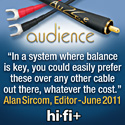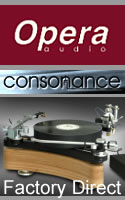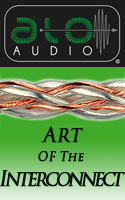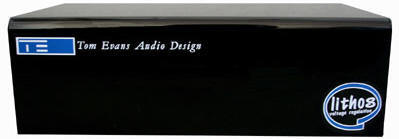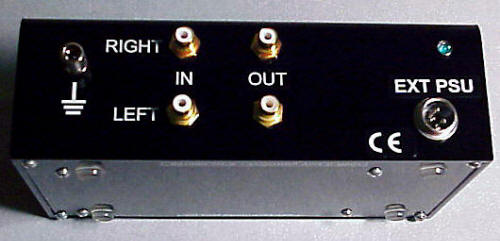|
|
You are reading the older HTML site
Positive Feedback
ISSUE
58
tom evans MicroGroove+ Phono Stage as reviewed by Larry Cox
Audiophilia is a strange world. Populated in equal parts by engineers and artists, science and voodoo, solid-state and tubes it is a collection of contradictions, each of which has, to my mind, some indefensible element that undermines claims of the sole knowledge in the arena of audio. Engineers and artists barely speak the same language. Some of the former think the latter have nothing to say and the latter think the former should not be allowed to say much. Scientists deride some of the voodoo which is unsubstantiated by data, and those who might be put in the voodoo category think objective data is irrelevant to experience. And, lastly, solid-state gear measures really well, and performs consistently while tubes may or may not measure well or perform consistently; and yet tubes have lassoed a permanent place in the audiophile conversation because of attributes the former simply hasn't been able to conjure up. I am appropriately a member of this population as I find myself subscribing to parts of all of those camps, but none without objection. When I started this hobby, I scoured specs and wanted nothing of tubes. I recall the ninety seconds of whirring, scratching and squealing sounds my dad's McIntosh amplifier went through warming up in the 1960s. Later I heard tales of tube failures causing catastrophic failure not only in the tubed unit but in some instances taking down an entire system. And, again, I recall my dad tossing his McIntosh amplifier and replacing it with a solid-state Dynaco. He proclaimed, engineer that he is, that the Dynaco was superior in every measurable way to the McIntosh. The Dynaco was not superior to my ears and I noticed his frighteningly loud listening sessions stopped shortly after that, replaced by silence. Better indeed. In response to years of being debilitated by Lyme's Disease, in 1987 I stopped resisting being an audiophile to take the place of the physical activity I had to give up. I spent a couple of years listening to gear discovering this amazing hobby and learning what was available. I discovered my preferences, but was unwilling to spring for tube gear given my experience and the widespread worries about tube failures. Instead, I spent good money on solid-state gear, more than I wanted in 1989. In show rooms I could hear that spending more money did make a difference, but was unwilling to try what had become an exotic item, tubes. The fifteen hundred dollars I spent on my initial high end amplification seemed like it should have bought me magic and satisfaction. It did not. And, I spent a few more years haunting audio salons hoping to find the magic solid-state gear. After finally acknowledging that I wasn't getting what I wanted, I finally took the leap and bought an Audible Illusions Modulus 2D tubed preamp in 1992. I figured that if I limited the number of tubes in my system, I'd limit system wide catastrophe. As with many things, the drama in the stories I heard exceeded my experience. I have had a tubed preamp and other tubed components in my system ever since then with nary a problem. Yes, I've had several tube failures, but no damage to my preamp let alone my whole system. I sprung for a tube preamp because in my mind it provided the only path to musical magic. Tubes provided weight and fullness to the timbre of music, that amazing thing called 3D imaging coupled to plainly more emotional experiences none of which solid-state could provide. Despite no problems with my preamps, I still wanted solid-state, but was unwilling to give up the magic and musical satisfaction tubes provided. I've heard good solid-state preamps since I bought the Modulus 2D and I could appreciate their qualities. I recall being ever so hopeful when I heard that Klyne Audio made really great phono stages. The Klyne's were certainly the best solid-state phono sections I'd heard. They were very smooth but lacked the emotional content and 3D realism I got from a decent tube preamp. Yes, it was good but I was not in like, let alone in love with their sound. With that as background, today I write about the Tom Evans MicroGroove+ phono stage. Recently I've re-explored solid-state amplification, not because I'm unhappy with my E.A.R. 864 preamp or tubes, because I'm not. Rather, it's a function of having a six year old and little time for music. These days the "pace" of my system is far more likely to be tested by the rhythmic beats of Super Mario Brothers or a movie than it is tested by extended listening sessions.
I happily embrace this lifestyle change but I'm alarmed that my 864 has been left on for days at a time because I'm no longer the sole caretaker of our system. Between my wife and son, three hundred dollars worth of 12AX7s and 12AU7s sometimes burn over night and over whole weekends because my family forgot to turn off the preamp and I didn't think to check. My bad? Sure, but that's a lot of Mullards to burn away in any event. Hence the origin of my interest in solid-state gear. The MicroGroove+ is the first product that I've asked to write about without having first at least heard in passing once. This is dangerous territory for me. I have very clear taste in sound. I know what I like and it doesn't take long for me to get to thumbs down. Just a few seconds in a show room and I know whether I'm intrigued or done. This is my very long winded way of acknowledging that it feels a bit odd to write about a solid-state phono section that I haven't heard before. But here I am, readying myself for the arrival of Tom Evans' solid-state phono section. Tom Evans was the designer of Michell Engineering Iso phono/Argo preamps, Pioneer Precision Range, and a then state of the art CD player (Acoustic Precision Eikos). Tom Evans Design is best known for phono sections; though he has expanded his offerings to whole preamps and amplifiers. The Groove and MicroGroove product lines have good reputations. I pretend little knowledge of electronics, but do profess to love listening and have some ability to articulate my experience. So, rather than fudge on facts I don't understand, let me quote from Tom Evans' website : "The Groove ($4000) RIAA stage is the result of over 10 years R&D into disk replay. In developing the Eikos CD player, Tom argued that as long as the voltage regulators supplying the board were noisier than the quietest passages recorded, and their transient response time was slower than the devices were capable of, there was no point in improving the circuit topology until these fundamental problems were solved. Two years later, he had developed the Lithos voltage regulator, a milestone in musical reproduction. The device is 53 times faster, 1000 times quieter, and 5 decimal places more accurate than the previously 'best' regulators available. Thus was laid the foundation for The Groove phono stage." The Groove was Tom's second commercial phono section work. What's on hand here, the MicroGroove+ ($2100), is the top of the MicroGroove line. It features trickle down technology from what Tom learned in developing the Groove. The MicroGroove+ is considerably less costly to make and purchase, and probably awaits a much larger array of possible buyers than the Groove line. Here's what he says about the product on hand: "Rather than compromise on components "The MicroGroove" utilises the same basic circuit topology as its predecessor, i.e. a low noise Class A front end device providing gain, feeding a passive equalisation circuit, followed by a phase error correction circuit with an active DC servo around the correction stage to roll off subsonics and DC offset. To reduce costs, both channels are built onto a single board powered by a single power supply. In "The MicroGroove+", the proprietary discreet Lithos regulator is included to greatly improve the quality, transient response time, and noise figures of the voltage rails supplying the whole board. This brings the benefit of CD-like dynamic range, neutrality, resolution and the ability to clearly define the edges of notes and the spaces between." The MicroGroove+ and many of Evans' stable of phono horses are built to suit either low output MC or high output MC/MM/Decca specifications, the 'X' version in MC form provides 5 values of cartridge loading per channel to support a wide range of MC cartridges. A word to the wise, the less costly "MicroGroove" (sans appellation) phono sections are built to particular cartridges. System: My regular reference system has been stable for about five or six years, excepting the two year old Dynavector XX2MkII (which I still think is a fabulous cartridge). I like it. My system is rather revealing, though not of the bleeding edge variety. What I mean by revealing is not that every hair out of place is highlighted under this microscope, but that great recordings sound great, good recordings good and bad recordings... well, that's the price of neutral. Some might find its performance lacking in sweetness... on some recordings, frankly most. But on magical LPs it sounds magical, too. But it is an appropriate balance for a reviewer and someone who wants to hear what's on the record. With my system, I am stuck hoping that what is on the record is good, rather than hoping that the phono amplification will make it better. When the recording is in the groove, so to speak, so am I as a listener and I'll accept that tradeoff. Prior to shipping the phono section Tom indicated that the MicroGroove+ might take a couple hundred hours to open up. When he shipped it, he said even so it should sound "pretty good" right out of the box. Arrival Upon arrival in Los Angeles from Wales, I wanted to make sure that the MicroGroove+ was operational, so I put on Ry Cooder's Chicken Skin Music. Tom was right about the sound, except the phono section sounded more than pretty good. My natural concern about solid-state phono sections, indirectly expressed above was that I'd be stuck with a thin and lean sound. Banish the thought. The MicroGroove+ is full bodied and balanced. No full bodied versus thin dichotomy here. Tubes versus solid-state sound? Not here. Somewhat ironically, I found the MicroGroove+sounded as rich as my E.A.R. 864's phono section, which is an E.A.R. 834p (three tubes) following a tweaked E.A.R. 843L circuit (two tubes), which is to say a solid-state preamp sounding like one with lots of tubes burning away. Perhaps upon initial installation, the MicroGroove+ was not as full-bodied as the E.A.R., and perhaps it was. I'm not sure. My first disc, Chicken Skin Music was certainly not lean or thin sounding nor was it on Cooder's Into the Purple Valley. Both of these "roots" music discs can be quite good sounding and that was my impression with the MicroGroove+. My next initial experiment with the MicroGroove+ was to see if I was getting good sound because of euphony. My vinyl enjoyment with the MicroGroove+ instantaneously disappeared once an RCA Red Label of Dvorak's New World Symphony began spinning - its usual thin, lean and awful midrange and treble weren't prettied up. The MicroGroove+ did this poor recording no favors. To facilitate "break in" to return the phono section within the agreed upon review time period, I inquired about using the Granite Audio phono break in CD. I'd never used this before and had no idea of it's efficacy. Tom suggested using the CD on its lowest voltage setting, unfortunately the lowest setting was four volts which would have made the phono section clip wildly, as it clips with a signal over 2 volts. So I still don't know that CD's efficacy. But, here's a word to the wise, use break in devices with care. The MicroGroove+ and all of Tom's preamps are small. So what, you might say. Well, heavy or stiff cables may well push it around or pull it off a stand. Ensemble Dynaflux cables nearly knocked an RS Labs RS A-1 tone arm and Koetsu Rosewood Standard off my turntable, so it was not idle worry for me. Inadvertent clumsiness (is there any other kind?) might cause one to knock it off the shelf. My greater concern, however, was the meter long captive power cord between the MicroGroove+ and its external power supply. In other systems, this might not be a problem, but I live next to a ham operator with a powerful transmitter. More often than I've liked, his transmitter bled into my system like an antenna and ended listening sessions. Would extra antenna length, err, a long captive power cord present a problem in my system? Fortunately, for a period of time the MicroGroove Plus's (MG+) I had no problems with my neighbor's ham operation. That was a delightful surprise. Regrettably my very worthy neighbor passed away ending that experiment, one I'd have lived with, however inconvenient. It appears that Tom is onto something with his focus on quiet circuits, whether that is a function of the Lithos voltage regulator or some other facet of his design, the MG+ was remarkably quiet. Really quiet. The quiet yielded nuances in performance and revealed harmonic arcs more clearly. I played Louis Armstrong and Duke Ellington's Recording Together for the First Time for a friend's 17 year old son. His untrained ears elicited the response "Wow, it feels like music and not a recording!" (emphasis is mine) In my system, with the MicroGroove+, the sound of this recording is like it was made yesterday with its pristine, relaxed, yet detailed sound rather than fifty years ago. It's very close to live music in my system. Cues buried deep in this ancient recording exhibited as rich a sense of timbre as I've had in my system, tubed, vinyl or otherwise. Recording cues about space, dynamics and instrumental interplay stirred up an experience of live music and the Wow! mentioned above. Though recorded in mono, ethereal and metallic cymbals (how do ethereal and metallic happen together?) blossomed out of nowhere without a hint of harshness before disappearing into the ether. Satchmo's vocals sounded very realistic, warm, full bodied in the middle of his vocal range and dryer further up. The MicroGroove+ is of the ilk that serves neutrality such that recordings are magical or not. But the experience seems to be different not only from recording to recording but from track to track. I found myself listening broadly and deeply in my musical catalog to discover that. While I loved the many years I spent listening to a Koetsu Rosewood Standard, I could not and would not have that be my only cartridge again, it's too colored. It's appealing character, unfortunately whitewashes (sweetwashes?) nuances in good quality recordings. Don't get me wrong, it's a really nice cartridge, but it's a bit like a flashy coat, good for some times and some clothes, but completely wrong for others. Both the XX2MkII and the MicroGroove+ are neutral in a good way and should be welcome all around town and at nearly any time of day, so to speak. The MicroGroove+ is an exceptional quality, neutral product that will serve jazz, from small ensembles like Canonball Adderly's "Something Else" and big band (Count Basie's "Farmer's Market Barbeque"), would-be jazz like Pink Martini's Hang on Little Tomato, Sympathique and Hey Eugene! as well as classical music, Beethoven's Ninth with the Mormon Tabernacle Choir, Grieg's Piano Concerto in A Minor, Rodrigo's Concierto de Aranjuez. Yes, I even pulled out Michael Jackson's Thriller and Off the Wall and also with a bit of embarrassment, my collection of Earth, Wind and Fire. I've serially disavowed an interest in imaging and soundstaging, without disparaging those that like it. Yet, I found myself cozying up to a near field listening position with my ATC SCM20-2A speakers, because that's where their imaging rises to stunning. I found myself enjoying the exceptional soundstaging of the MicroGroove+ and the rest of my system. With great trepidation I found myself wondering how long it would take for me to afford ATC's SCM 50A speakers. Those speakers, very much of the same woof and warp as my reference but which are designed for midfield listening positions. With more soundstage to enjoy the MicroGroove+'s exceptional imaging might expand to create an even larger, squarer, more fully threshed out sound stage; and allow me to pull my nose back from the front of the speaker plane to retain the exceptional imaging qualities. The MicroGroove+ provided the best imaging I've had in my system to date. Perhaps this animal is changing his stripes? For those readers who want the missionary position, er standard report on the MG+, i.e. bass, midrange and treble, here goes. Bass was plenty deep—I'm using a 15" subwoofer I built for my brother in law, with a second in the works—and the bass was tight and fast, and fit in with my speakers and system very well. If a recording has bass, like Also Sprach Zarathusa, from 2001 : A Space Odyssey, deep bass will be present. I hunted through my record collection to find bass, including the dynamic, bit low level counterpoint of deep bass in my Mobile Fidelity remastering of EMI's Edward Elgar's Sanguine Fan, the opening of Grieg's "Piano concerto in A Minor." The MicroGroove+ performed admirably. Midrange tone was not sweet, but really well replayed with a mesmerizing presence and reality to vocals, both male and female. Again, this seems to underscore the value of a quiet preamp. I have found in the past that sometimes preamps that excel with one gender or the other do so with a coloration, however pleasant that coloration might be. Female vocals could be exceptional with an exceptional recording or rather mundane and disappointing with this review piece depending on the recording. Pink Martini's rendition of "Tea for Two" on Hey Eugene! features Jimmy Scott in a duet with China Forbes. While Forbes' tone is easily superior to Scott's, the latter's emotive content rather embarrassingly easily eclipsed the former's. Treble extension was good, essentially unnoticeable. I'll say that I don't know that my ATCs are as open or extended sounding as my previous reference speakers, the GamuT L5 speakers with their Revelator tweeter. But in any event the MicroGroove+ seemed to dig out as much treble as I recall hearing on my recordings. I tried the MicroGroove+ through a mid-fi Onkyo 885(b) preamp processor. Phono replay was superior to digital on the Onkyo, no question. The MicroGroove+ did not, however, transcend the Onkyo, which leads me to believe that getting the full gestalt of Tom Evans' designs might require listening to the MicroGroove+ through Tom's Vibe line stages or at least through a superior quality line stage like E.A.R.'s 864. Comparisons I've heard a number of contenders in the less costly end of phono sections, though recently I have only heard Ray Samuels F117 Nighthawk. This unit is a serious over performer at its $800 price. At almost three times the price, the MicroGroove+ is more precise, more relaxed and more full bodied than the Nighthawk. Like the MicroGroove+ the Nighthawk is a stunning refutation to the assertion that solid-state gear can't image well, but again Tom Evans' device was more relaxed and realistic, like a well ironed but unstarched shirt. If you only have $800 for a phono stage, the Nighthawk will be a very transparent, if not also buttoned down performer, but it's not really a competitor to the MicroGroove+. Naturally, the E.A.R. 834P phono stage should be mentioned as that is not only my reference, but is about the same price point. The pair were remarkably similar, no doubt because both played through the tweaked E.A.R. "834L" section of my preamp. The MicroGroove lacked some of the organic qualities the tubed phono section brings and which has endeared it to me. However, I can hear a bit of the coloration of the 834P here, in that it provides a bit of "nice-ing" up things in the midrange, and a wee bit of plumping of the bottom end much as the Koestu Rosewood did, though to a far, far lesser extent. It should be pointed out that while the 834 has a reputation as having a tubey quality, that may be a function of being placed in systems predisposed to such a sound. My system doesn't sound tubey, even though it has five tubes in it. I find it hard to fault the MicroGroove+. I liked it a lot, and were it available when I first started down the audiophile road, I probably would not have taken the tubed path. However, all compliments and no short comings reads disingenuous, though I assert I am not. Were I to find fault with the MicroGroove+, I expect that there are more refined preamps, much as there are better systems than mine out there. I have experienced more "beautiful" music with some preamps, but those preamps also whittled my listening catalog to fewer and fewer great recordings rather than music I like to listen to, somewhat akin to the flavoring of the Koetsu Rosewood. I'll assert that every review is partially about the reviewer as well as the item under review, the MicroGroove+ is a fit for my taste in music and the sound I'm after. The MG+ hews toward neutrality with no eye toward retaining euphonics. Rather than being a Photoshop for vinyl, it's like cleaning a camera lens, allowing you to see more, whether that's flattering or not. I really like Tom Evans' MicroGroove+. Listeners who want to hear their recordings well replayed, rather than dressed up need to hear the MicroGroove+. When recordings are terrific, the sound of the MicroGroove+ is, too. Imaging and soundstaging are very well served as is the music. I do recommend it to any audiophile looking for superior, immersive replay of analog audio. In a world dominated by tubes, vinyl playback has an excellent solid-state constituent in the MicroGroove+. If you own a tubed phono stage because you feel a need for a fuller sound, you can add Tom Evans MicroGroove+ to your list of candidates without worry of losing the rich timbre that tubes provide. Totally way, exceptionally recommended, dudes! I'm looking forward in the near future to sampling the fruit further up the Tom Evans Design Group's audio tree, I recommend you look, too. Larry Cox
MicroGroove+
Tom Evans
|
